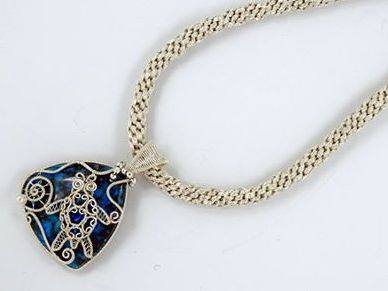I am really enjoying being able to feature different designers in this blog. My aim is to show a wide range of talents and styles in order to demonstrate just how versatile kumihimo can be. The designer I have chosen for today is someone who is famous for a very different medium, so the kumihimo plays a supporting role, rather than being the star of the show.
Rachel Norris is best known for her unique wirework designs inspired by the natural world. She has many television appearances to her credit, including the BBC, she is regularly published in magazines, she teaches at workshops and masterclasses and has even had her work exhibited in the Victoria and Albert Museum. In her hands a few lengths of wire and a cabochon or two turn into something totally magical, but what I want to explore here is the way that she uses kumihimo to complete her designs.
First of all, in her own words, this is what she likes about kumihimo,
‘ I love the chunkiness of the braids, their immediate ability to provide wearable classy and comfortable neckline pieces. I adore the neat and precise braid weave texture. Kumihimo braiding offers me as a designer, the abilty to pick colours out from the gemstones and wire that I have used and I can carry them on throughout the braid to give continuity to the design.
Rachel kindly supplied me with lots of images to choose from, but I know that people are going to want to see as many as possible, so I am using nearly all of them. The chunkiness of the braids comes across in all of the designs. These are very substantial and intricate focal pieces, which need to be hung on something which is both physically and visually strong. Kumihimo is perfect for this and as braids can be made in any thickness, they give a designer the opportunity to create exactly the effect they want.
Rachel mentions comfort and this is often overlooked in jewellery design. There is no way of assessing comfort from an image, but lovers of kumihimo know that it is very comfortable against the neck, even when it is carrying heavy pendants. Always carry out user trials on your work, so that you can be sure of the comfort level and be cautious of metallic yarns and cords, which can be scratchy. Try using metallic cords with thicker cords so that only the thicker cord is in contact with the skin.
I am totally in agreement with Rachel about the texture of the braid. You can have a lot of fun playing with the texture by introducing interesting yarns and cords. Detailed work like Rachel’s is the sort of jewellery which will be scrutinised closely, so it is worth paying attention to the materials for the braid. Rachel uses a wide variety of materials, but I particularly like her use of wire mesh. This is a great material to use because it gives the metallic look and at the same time offers a very smooth, comfortable feel. The braid in the fish design above and the butterfly below is made with wire mesh. Look closely at some of the other designs and you will see more wire mesh used to great effect.
In the lizard and the giraffe designs Rachel has played with different types of cord to achieve just the effect she wanted. In this case it was silk cord mixed with waxed cord. Don’t forget that mixing cord can also help to keep the cost down.
The final point I want to pick up on is colour. I believe that kumihimo braids offer an unrivaled opportunity to match up or contrast colours. Gemstones or beads with AB coatings have a wide range of colours within them and they can look different in varied light conditions. By using materials such as embroidery threads, knitting yarns or S-Lon cords you can really create any colour scheme your imagination can dream up.
Do take the time to study all these amazing designs in detail. If you are feeling inspired by Rachel’s wirework I recommend taking a look at her Facebook page.
Rachel has produced some very comprehensive DVDs which have helped many people to develop their skills and find their own style. It is also well worth trying to get a place on one of her workshops or masterclasses if you prefer face to face tuition.
Here is one last image to enjoy!







